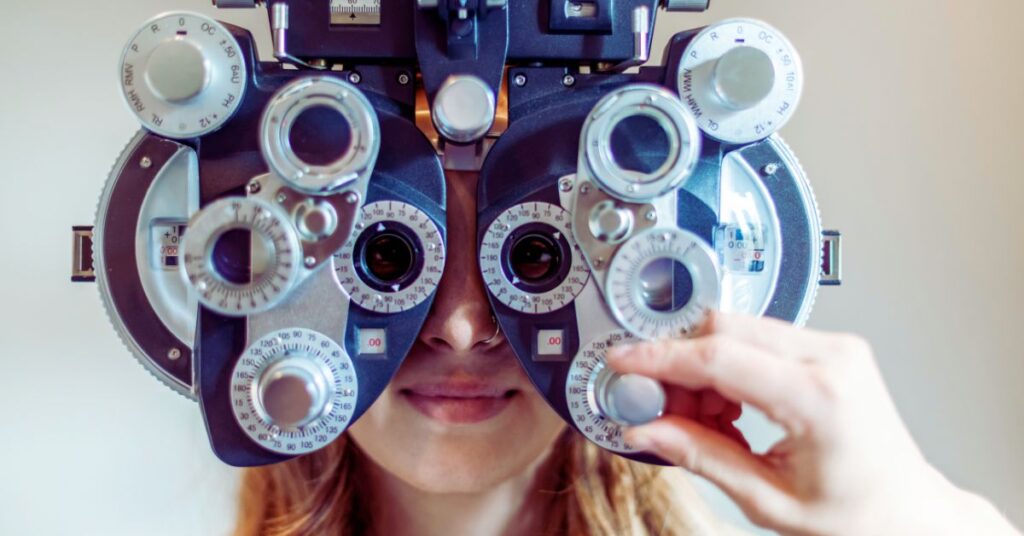Eye health is a crucial aspect of overall wellness, often overlooked until problems arise. In Houston, where people are constantly moving, a comprehensive approach to eye care is essential to maintaining healthy vision. “Houston Family Eyecare” stands out as a critical resource, offering various services to meet every family member’s unique needs. This guide explores why eye care is essential and provides practical advice on maintaining eye health for all ages.
Why Regular Eye Exams Are Crucial
Regular eye exams are vital in preserving eye health and preventing vision loss. An eye exam can detect more than just vision changes; it can also identify early signs of severe health conditions like diabetes, high blood pressure, and certain types of cancer. During an eye exam, optometrists look for signs of common eye conditions such as glaucoma, macular degeneration, and diabetic retinopathy — conditions that can develop without noticeable symptoms.
Regular eye check-ups, ideally once every one to two years, depending on age and health status, help catch these conditions early when they are most treatable. Additionally, regular exams ensure that prescriptions for glasses or contact lenses are up-to-date, enhancing comfort and reducing strain.
Understanding Common Eye Conditions
Several eye conditions are prevalent among the general population. Nearsightedness (Myopia) is where distant objects appear blurry, while farsightedness (hyperopia) causes nearby objects to blur. Astigmatism leads to blurred vision due to an irregularly shaped cornea or lens. Although these issues are easily corrected with glasses or contact lenses, more severe conditions like cataracts and glaucoma require more attention.
Cataracts cause clouding of the eye’s lens, affecting vision clarity, and are a leading cause of blindness in older adults. Glaucoma is characterised by damage to the optic nerve, often due to high eye pressure, and can lead to irreversible vision loss if untreated. Understanding these conditions allows individuals to seek timely care and prevent long-term complications.
What to Expect During an Eye Exam
An eye exam is a straightforward process involving painless tests to evaluate vision and eye health. The exam typically starts with a visual acuity test, where the patient reads from a chart to measure how well they see at different distances. The optometrist may also perform a refraction test to determine the correct prescription for glasses or contacts. Additional tests, such as tonometry, measure intraocular pressure to screen for glaucoma.
Other tests include pupil dilation, which allows a closer look at the retina and optic nerve, and retinal imaging, which captures detailed images of the back of the eye. Preparing for an eye exam involves noting any symptoms, bringing current eyewear, and having a list of medications, as some can affect eye health.
Choosing the Right Eyewear
Selecting the proper eyewear goes beyond choosing a stylish frame. It involves considering lens material, frame shape, and lifestyle needs. For instance, polycarbonate lenses are ideal for children and sports enthusiasts due to their impact resistance, while progressive lenses are suitable for those needing different prescriptions for distance and reading.
Blue light-blocking lenses are recommended for those who spend extended time on digital screens to reduce eye strain. When choosing frames, consider facial shape, personal style, and weight and comfort for prolonged use. Optometrists often guide patients in selecting the best options based on their unique needs, lifestyle, and preferences.
Pediatric Eyecare: Why Kids Need Special Attention
Children’s vision requires special care due to its rapid development during the early years. Early eye exams can detect issues like amblyopia (lazy eye), where one eye is weaker than the other, or strabismus (crossed eyes), leading to coordination problems. If caught early, both conditions are often treatable with glasses, patches, or vision therapy.
Vision problems can significantly impact a child’s learning ability, as much classroom learning is visual. Signs of potential issues include squinting, tilting the head, frequent eye rubbing, and difficulty maintaining focus. Regular paediatric eye exams are recommended starting as early as six months, again at three years, and annually after starting school.
Eyecare for Seniors: What Changes with Age?
Ageing brings specific challenges to eye health. Presbyopia, a common age-related condition, causes difficulty focusing on close objects. Cataracts, which develop gradually and cause the eye’s lens to become cloudy, are another common issue among older adults, leading to blurry vision and glare.
Macular degeneration affects the macula, the central part of the retina, and is a leading cause of vision loss in people over 60. Seniors are also at an increased risk for glaucoma due to changes in eye pressure. Regular eye exams and a tailored eye care plan are essential for detecting and managing these age-related conditions early, helping maintain independence and quality of life.
Contact Lens Care: Tips for Beginners
Understanding care basics is essential for comfort and eye health for those new to contact lenses. Start by choosing the right type: soft lenses are famous for comfort, while rigid gas-permeable lenses provide sharper vision and are more durable. Always wash hands thoroughly before handling lenses and use only recommended cleaning solutions.
Avoid wearing lenses longer than prescribed, as overwearing can lead to dryness, irritation, and infections like keratitis. For beginners, it’s also essential to get used to inserting and removing lenses and have regular follow-ups with an optometrist to ensure the lenses fit correctly and the eyes remain healthy.
How Digital Screens Affect Vision
Spending long hours in front of digital screens can lead to digital eye strain or computer vision syndrome. Symptoms include dry eyes, headaches, blurred vision, and neck or shoulder pain. These problems are caused by staring at screens for extended periods without breaks, exposure to blue light, and poor posture.
To mitigate these effects, consider adjusting screen brightness, using anti-glare filters, or installing blue-light-blocking apps—position screens at arm’s length and slightly below eye level to reduce strain. The 20-20-20 rule is highly recommended: every 20 minutes, take a 20-second break and look at something 20 feet away.
Nutritional Tips for Healthy Eyes
A balanced diet rich in specific nutrients plays a vital role in eye health. Vitamin A in carrots and sweet potatoes helps prevent night blindness and maintains a clear cornea. Vitamin C, found in citrus fruits, is an antioxidant that helps protect against cataracts. Vitamin E, found in nuts and seeds, and zinc, found in meats and shellfish, also help prevent age-related macular degeneration. Omega-3 fatty acids in fish like salmon support retinal function and prevent dry eyes. Incorporating these nutrients into daily meals can significantly reduce the risk of developing common eye conditions.
Importance of UV Protection
Protecting the eyes from UV radiation is crucial in preventing long-term damage. Prolonged exposure to UV rays can increase the risk of cataracts, macular degeneration, and even eye cancers. Wearing sunglasses that block 100% of UVA and UVB rays is essential, even on cloudy days. Polarized lenses reduce glare, making them ideal for driving and water sports. Wide-brimmed hats can provide additional protection by blocking sunlight from above. For those who wear prescription glasses, photochromic lenses that darken in sunlight can be a convenient option to ensure constant UV protection.
Vision Therapy: What Is It and Who Needs It?
Vision therapy is a non-surgical treatment designed to improve visual skills and abilities. It is particularly effective for children with strabismus (crossed eyes), amblyopia (lazy eye), or eye tracking and focusing difficulties that affect reading and learning. Adults experiencing persistent digital eye strain or those recovering from a concussion may also benefit.
The therapy consists of eye exercises, often combined with lenses, prisms, or computer programs, to strengthen the eye muscles and improve coordination. The goal is to enhance the brain’s ability to control and coordinate eye movements, resulting in better vision and reduced symptoms.
Eye Health Myths Debunked
Many myths about eye health persist, leading to confusion and potential harm. Contrary to popular belief, reading in dim light does not damage eyesight permanently; it may cause temporary discomfort but does not cause long-term harm. Wearing glasses or contact lenses does not weaken the eyes; they correct refractive errors and allow for clearer vision. Another common myth is that sitting too close to the TV will damage the eyes. This is false, though it may cause temporary eye strain. Understanding these myths helps individuals make informed decisions about their eye care.
Finding a Local Optometrist in Houston
Choosing an optometrist in Houston can feel overwhelming, but some factors can help narrow the options. Consider the optometrist’s experience and qualifications, and look for patient reviews and testimonials. A local provider offers convenience, understands the unique environmental factors of Houston, such as allergies and UV exposure, and can offer tailored advice accordingly. It’s also helpful to ask about services such as pediatric care, contact lens fittings, and vision therapy to ensure they align with specific needs.
Conclusion
Eye health is an essential part of overall wellness that requires proactive care. Regular eye exams, protective measures like proper eyewear, and a nutritious diet are crucial to maintaining healthy vision. Whether young or old, everyone can benefit from understanding the importance of comprehensive eye care and taking steps to protect their sight. Prioritizing eye health now ensures a more transparent and brighter future.
For more tips on Health and Fitness click here
FAQs
How often should someone get an eye exam?
Most adults should have an eye exam every one to two years, while children and seniors may need annual check-ups, especially if they have existing eye conditions or risk factors.
What are the first signs of eye strain?
Early signs of eye strain include headaches, blurred or double vision, dry or watery eyes, and difficulty focusing, especially after prolonged screen use or reading.
Are contact lenses safe for children?
Yes, contact lenses can be safe for children, especially older kids and teenagers. Proper hygiene, regular follow-ups, and education on lens care are crucial for safety.
How do we know if sunglasses provide adequate UV protection?
Check the label to ensure the sunglasses block 100% UVA and UVB rays or have “UV 400” protection, indicating complete UV filtering.
Can diet improve vision?
A healthy diet rich in vitamins A, C, E, zinc, and omega-3 fatty acids can support eye health and reduce the risk of developing certain conditions like cataracts and macular degeneration.



